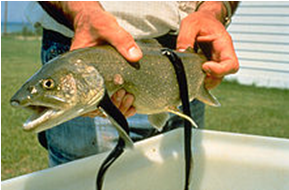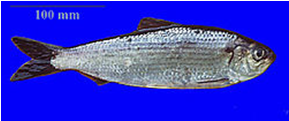
Vol. 7, No. 8, August 2011 |
 Printer-Friendly PDF Version Printer-Friendly PDF Version |
USDA Gets Aggressive In Settling Old Issues
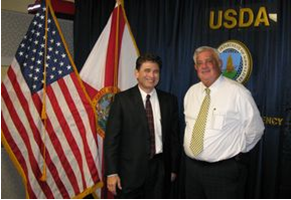
Fred Pfaeffle, USDA Deputy Assistant Secretary for Civil Rights (L) and Florida FSA Director Tim Manning. (Rick Sapp photo, July 2011)
When Fred Pfaeffle visited Florida last week, he had one message. “Let’s clean up any lingering issues from the past and move forward aggressively toward a new and inclusive agricultural community.” Fred is Deputy Assistant Secretary for Civil Rights in USDA. FSA State Director Tim Manning introduced him to producers and agency personnel around the state.
Between 1980 and 2000, the USDA was not always able or – sometimes – willing to accommodate agricultural opportunities for women, Hispanics and other minorities, Pfaeffle said. “The policies and procedures which USDA’s 100,000+ employees were charged with administering had a checkered history in civil rights. USDA was created as ‘the people’s department’ by the Lincoln administration in 1862 and there have been immense demographic changes since then. We didn’t always keep up with the times. Today, 20 percent of kindergarten kids in the U.S. are Hispanic and women are taking a leading role developing specialty crops, niche markets.
“Secretary of Agriculture Tom Vilsack has made it clear that he wants to move aggressively to meet the challenges of agriculture in the 21st century…and there are plenty of them. One of the first tasks though is to clear up any systemic or lingering problems with the department.”
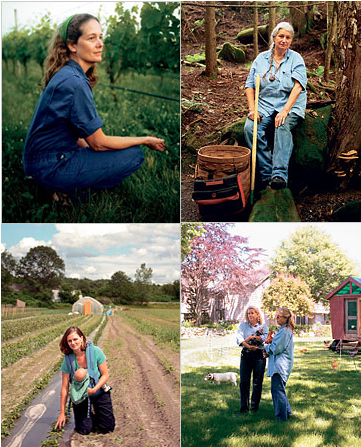
Photo courtesy DownToEarth.com
Manning admitted that wide publicity of USDA’s checkered national civil rights record was something of a black eye for the agency. “But this initiative gives us a chance to put things right,” he argued. “That’s why we want to publicize these efforts as widely as possible. No, we didn’t always treat everyone equally. We admit it. The programs that are now in place though give us a chance to right those wrongs as much as possible.”
A “cultural transformation” in customer service is the way Manning described the efforts now underway, in part due to Pfaeffle’s visit and in part due to public outreach programs to women and Hispanics. “We may have to do more with less at the moment,” Florida’s FSA Director says, “but our objective is to become a more efficient agency.”
USDA is asking that anyone who was denied a farm loan or loan servicing between (roughly) 1981 and 2000 – and who believes this denial was principally because they were a woman or were Hispanic – to review the claims process on line at www.farmerclaims.gov. Alternatively, they can visit an FSA office or ask for assistance from their county agent to begin the process. Manning supplied the following pdf documents for additional information and contacts:
- Click here for a summary of the claims process for women and Hispanic farmers and ranchers: who qualifies, the claims process and assistance with filing a claim.
- Click here for the framework for Hispanic or female farmers’ claims process: purpose (cash payments and other relief, tax relief, debt relief, sources of funding and claims period), notice, the administrator, the adjudicator and required procedures (claims package, irrevocability, release of liability, voluntary participation and oaths), the statute of limitations and the decision making process.

Guadalupe Garcia, Jr. is among the plaintiffs alleging USDA discriminated against his family and other Hispanic farmers. The farmers are also frustrated by a judge's decision denying them class-action certification.
“It is important to remember that USDA and its employees cannot give a person legal advice,” Manning said tim.manning@fl.usda.gov, “but you’re not required to hire an attorney to file a claim, although you may do so if you wish.”
“This is an attempt to expedite the process of becoming more open, more service-oriented, without lawyers,” Pfaeffle explained Frederick.pfaeffle@ascr.usda.gov, “but like Tim said, if you wish to consult an attorney, that’s also fine. It will not in any way affect the administration or adjudication process.”
[top]
SART Advisory Board to Meet
Please put Wednesday, September 21 on your calendar for the next meeting of the Florida SART Advisory Board. Meetings begin at 10:00 am and end no later than 2:00 pm. The meeting will be held in the Board Room of the Florida Farm Bureau adjacent to Interstate 75 in Gainesville. The Farm Bureau cafeteria is available for those who wish to have lunch at the Bureau.
For information contact Joe Kight, Senior Management Analyst II/ESF-17 ECO, Division of Animal Industry, 407 S Calhoun St., Tallahassee, FL 32399-0800 (850) 410-0920 Joe.Kight@freshfromflorida.com.
[top]
4th Annual Maddie's Shelter Medicine Conference
The Maddie’s Shelter Medicine Program at the University of Florida is hosting its 4th Annual Conference on October 29th and 30th at the Hilton University of Florida Conference Center Gainesville, Florida. Registration is $175 before September 15 and $225 afterwards.
“We invite veterinarians, technicians and program managers to two full days of continuing education during the conference,” writes Dr. Julie Levy, DVM, PhD, DACVIM, director of the Shelter Medicine Program.

Attendees at 4th Annual Conference of The Maddie's Shelter Medicine Program in October will learn about the most important challenges in shelter management. (Rick Sapp photo)
“We’ll have a great breadth of speaker expertise at this conference. Many of the topics, including behavior assessment tools and pain management in shelters, were suggested by veterinarians last year. Presenters will also address some of the most important challenges in shelter management:
- infectious disease control,
- maximizing the veterinarian’s role in protecting health and welfare of shelter pets,
- and development standard operating protocols that assure quality control and accountability in shelter care.
“New this year is a poster session called Frontiers in Shelter Medicine. Attendees are invited to present findings on any topic relevant to shelter medicine. Awards will be given to selected poster presenters who are currently enrolled in training programs, including undergraduate, graduate and professional students, interns and residents. This session provides an opportunity to share cutting edge information.”
Find out more about the 13 hours of advanced shelter medicine continuing education offered at this conference at http://conferences.dce.ufl.edu/Sheltermedicine/ and learn more about the shelter medicine program at www.ufsheltermedicine.com.
Director of Maddie's Shelter Medicine Program
at the University of Florida.
Q: Is the field of shelter medicine growing and changing?
A: Yes. There’s a growing demand for animal-friendly solutions. That demand is challenging traditional sheltering concepts which are based on a reactive, animal control model. By that I mean changing from a model in which large numbers of animals are processed through shelters with a high euthanasia rate to one in which proactive preventive measures – Operation Catnip, for example, which works to humanely reduce the feral cat population by spaying and neutering stray cats – reduce shelter admissions and increase adoptions of healthy animals.
Q: How does the role of the shelter medicine program at the College of Veterinary Medicine, University of Florida mesh with other disaster response programs?
A: The University of Florida Veterinary Emergency Treatment Service (UF VETS) is a state-supported resource for SART and is part of the college's commitment to providing care for animals displaced by natural and man-made disasters. The current role is:

Julie K. Levy, DMV, PHD, Diplomate ACVIM, is Maddie’s Professor of Shelter Medicine Director at UF levyjk@ufl.edu.
- to provide an assessment of animal care infrastructure in the early hours after a disaster,
- to provide logistical support as requested by disaster managers,
- to oversee and provide medical assistance to animals temporarily housed in shelters and
- to help shelters and veterinary clinics resume operations following a disaster so that they can take over the care of homeless and injured animals.
Under Maddie’s Shelter Medicine Program, we’re expanding our role to provide training in disaster medicine to veterinary students, shelter medicine residents, veterinarians, technicians and shelter workers through courses, laboratories and field exercises.
Q: Is the question of taking care of animals just a function of living in a wealthy society?
A: No. I’ve been to the Galapagos Islands, which are part of Ecuador, and to India – nations not particularly known for a high standard of living for the average citizen – and found that the people there are just as concerned for their animals as we are in the U.S. I feel that people everywhere are interested in the well-being of their animals and that they always have been.
Q: Has the television network “Animal Planet” helped or hurt the cause of animals?
A: I don’t think there’s any question that the television shows have raised awareness of animal issues whether it is the way we treat our pets, to dog fighting and hoarding, to industrial chicken farming. Hoarding, for instance, is a human pathology, sort of like an addiction to alcohol or drugs, and treatment is not well understood. The relapse rate for animal hoarders is practically 100 percent.
Web sites of interest: Maddie’s Shelter Medicine Program at the University of Florida http://www.ufsheltermedicine.com/meetTeam.html and Operation Catnip of Gainesville http://www.facebook.com/#!/operationcatnip.
[top]
Broward County to Host
G-358: Evacuation/Re-Entry Planning
Broward County’s Emergency Management Division will host the course “G-358: Evacuation and Re-Entry Planning.”
G-358 is a 12 hour/2-day course that helps participants understand issues involved with the planning of local evacuations and re-entries. It’s an opportunity for local agencies to discuss planning for successful local evacuation and re-entries with state representatives. G-358 does not address the decision about when to evacuate or re-enter, as those are inter-governmental decisions. The Florida Division of Emergency Management (FDEM) says the class includes information about evacuation of service and/or companion animals.
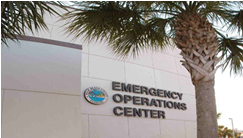
Dates: Wednesday, September 28-29
Time: 8:30 am - 5:00 pm both days
Location: Broward County EOC
201 NW 84th Ave., Room 332B
Plantation, FL 33334
Instructors: Jeff Alexander and Sandy Myer
This course is an elective in the Advanced Professional Series (APS) certificate program.
The Florida Division of Emergency Management (FDEM) is handling registration through www.floridadisaster.org/TrainingCalendar/admin_moreinfo.asp?id=23.
FDEM’s Calvin Williams is Course Manager – (850) 413-9879 or Calvin.Williams@em.myflorida.com.
[top]
 | Palm Beach County Tests |
In July, Palm Beach County emergency crews participated in an exercise to train for helping the public during a nuclear emergency. According to Alexandra Seltzer, a staff writer for the Palm Beach Post, “The exercise tests the response of emergency crews in handling the almost 230,000 people that would need to be evacuated if there was a nuclear emergency at the power plant.”
Emergency crews from Palm Beach County Fire Rescue checked people and animals for contamination at several public parks. “It's a first stop to assess people, provide information and triage them,” said county Emergency Management Director Bill Johnson.
 | The two 802 MW St. Lucie nuclear reactors were built in 1976 and 1983, respectively. They were part of a study called Calculation of Reactor Accident Consequences or “CRAC II,” a “worst case scenario” simulation performed by Sandia National Laboratories for the Nuclear Regulatory Commission. The report concluded there would be 28,000 casualties and $113 billion property damage from a major accident. It is important to note that the study was published in 1982. The twin plants on Hutchinson Island are owned primarily by Florida Power & Light. |
The “victim,” who might have been a person with their pet, walked through a radiation detector similar to an airport metal detector. If radiation was found, they – both the people and the pets – got a good scrub and then were then given the option of going to a nearby shelter. Even vehicles in the plume of contamination were monitored and washed if radiation was found.
“We were able to fine-tune our standard operations and guidelines,” said SART member, Lt. Daisy Harsch. “It was good drill, even though it was called due to bad weather. Next year’s exercise will be officially evaluated by the FEMA-ites.”
Check http://www.palmbeachpost.com/news/palm-beach-county-teams-test-nuclear-disaster-response-1604334.html?cxtype=rss_news for the article and photos in the Palm Beach newspaper.
[top]
Panama Canal Widening
Brings Opportunity … Possible Problems
Out of sight, out of mind?
Native to southeast Russia, the zebra mussel arrived in America on ocean-going ships in 1988. Transported on recreational vessels, they are now found throughout the Great Lakes region and have been documented in California. They can grow so densely that they block pipelines, clogging water intakes of municipal water supplies and hydroelectric companies. The cost of fighting them – eradication is out of the question – is in the hundreds of millions of dollars. This, added to the curse of the alewife through the Welland Canal and the sea lamprey through the Erie Canal ….
Is Florida next?
 Zebra mussel-encrusted Current Meter in Lake Michigan. |
| ||
The 48-mile Panama Canal was built almost 100 years ago to connect the Atlantic and Pacific Oceans. Its combination of double locks and artificial lakes cut sea travel distance and time between the west and east coasts in half. A New York to San Francisco ship via the canal travels 5,900 miles, instead of 14,000 miles around Cape Horn.
Millions of tons of shipping pass through the canal every year taking 8-10 hours for the passage and paying an average of $54,000 per ship. In 2008, 14,702 vessels carried 309.6 million tons through the canal.
Now, many big container ships are too large for canal locks. Thus, a third set of locks is being added, big enough to handle all but the very largest seagoing supertankers. The new locks are 1,400 feet long and 180 feet wide. Ships will begin using them in 2014.
In anticipation of the opening of the canal, Larry Cretul – former Speaker of the Florida House of Representatives and now with the Florida Chamber of Commerce – says he expects exports to double within the next five years. Florida Governor Rick Scott has requested $800 to prepare Miami for the 2014 opening.

Port of Miami, Florida
Terry Smith, Communications Chief with the U.S. Army Corps of Engineers says deepening the Port of Miami in anticipation of increased shipping and ship sizes has already begun. Tampa, Jacksonville and perhaps Pensacola will follow.
Dennille Folsom, Director of the Lake City/Columbia County Chamber of Commerce, says her county has begun planning for an “inland port.” Lake City lies at the crossroads of Interstates 75 (north-south) and 10 (east-west). Plus, the east-west Class 1 railroads CSX and Norfolk Southern, both freight carriers, have switching service available daily. Columbia High School is preparing high school students for careers in the logistics and distribution field through a program called the Global Logistics Career Academy and Florida Gateway College (the former Lake City Community College) is developing a logistics curriculum.
So change is on the way. What will it bring with it that may require economic and ecological response? Teresa Monson, Senior Communications Specialist with the St. Johns River Water Management District, Jacksonville says she hasn’t heard any discussion or proposals to resume the work on the Cross-Florida Barge Canal … at least, not yet.
[top]
News & Notes
The July issue of the SART Sentinel highlighted “all-hazard preparation and response” efforts in New Jersey. We spoke with Dr. Shari Silverman, VMD, who is a Senior Veterinarian with the NJ Department of Agriculture Division of Animal Health. She recommended we visit with Jack Burns, Coordinator for Emergency Management in metropolitan Hudson County www.hudsoncountynj.org/office-of-emergency-management--oem.aspx about the development of CARTs or County Animal Response Teams.
Here is what Hudson County says about itself: “Due west of and adjacent to New York City, Hudson County is the most densely populated county in the state and its citizens represent diverse cultural and ethnic backgrounds. It hosts one of America’s largest financial centers and is a major transportation hub that includes commuter and freight rail lines as well as the Lincoln and Holland tunnels. This heavily populated, metropolitan environment makes Hudson County communities particularly susceptible to various technological, manmade and natural disasters.” [edited for length]
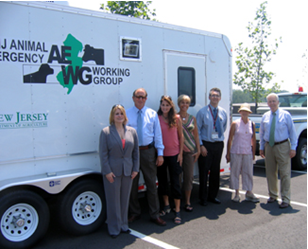
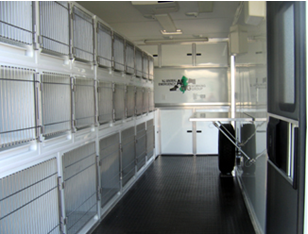
As this newsletter went on line, Hudson County received a 20-foot trailer with cages from the NJ Dept. of Agriculture. The trailer can provide temporary shelter or transportation for pets and livestock in emergencies. It has heating and cooling units, electrical and water hook-ups, generators and external light sources, giving users the ability to set up a temporary animal shelter at any location. The trailer was paid for with an Urban Areas Security Initiative Grant through the NJ Office of Homeland Security and Preparedness.
Top photo: Det. Gidget Petry, Bergen County OEM; NJDA Secretary Douglas Fisher; Niki Dawson and Joan Maciewicz, Hudson County CART; Dr. Manoel Tamassia, NJDA State Veterinarian; Dr. Shari Silverman, NJDA; and Jack Burns, Hudson County OEM.
Q: Who is in charge of emergency management in New Jersey?
A: The State Police http://www.njsp.org/. Emergency management is the statewide responsibility to prepare for, respond to and recover from emergent and disastrous incidents which occur beyond the capacity of municipalities and counties to effectively respond. In this capacity, the agency is also responsible for the coordination and support of emergency services at all levels, as well as the mitigation of the immediate damages from such incidents.
Q: What is the state of New Jersey’s CART program?
A: The CART program was mandated by state legislation, in typical New Jersey fashion with no money to support it. It was simply thrust on county emergency managers as another additional responsibility. We’re simply overwhelmed by the amount of work being shoved down the chute. It’s hard enough to take care of the people, but taking care of their pets too, pushes us over the limit. Without the volunteers I don’t know what we’d do.
Q: Sounds like you are stretched. How do you get it all done?
A: We’re lucky to have five full-time people in emergency management, but lots of counties only have one. Fortunately, we have a group of volunteers who have done yeoman work making our CART program happen. The team now has 14 people and even that’s just scratching the surface as we try to develop organizational parameters and training programs. There are some people who love animals more than people. We’re looking everywhere for funding support.
Q:What’s one unanticipated challenge you have had to plan for?
A: I would say that would be a ton of freelance volunteers – without training or organization – showing up after a disaster. If they are trained and part of the team they are a blessing. Otherwise, they can be part of the disaster.
For the latest update on New Jersey’s new animal emergency trailers, go to www.state.nj.us/agriculture/news/press/2011/approved/press110802.html
Alachua County Animal Services and UF’s Shelter Medicine club hosted the 2nd annual “Summer Loving” adoption event on Friday and Saturday July 29-30. It was held from 1 to 4 p.m. each day at the Alachua County Animal Services Headquarters, 3400 NE 53rd Ave.
For this event, the first 20 people to adopt (each day) paid only $5 (courtesy of the students in the Shelter Medicine club). All other adoptions were at Animal Services Event pricing: cats $33 and dogs $45.
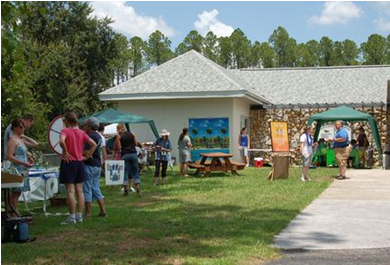 |  |
 | 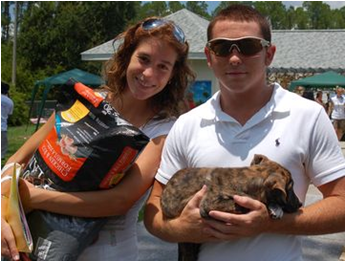 |
On Saturday, the Gainesville Police Department K-9 Unit offered a demonstration and the Sweet Dreams Fire Truck (ice cream for a $3 donation) and I Love New York Pizza offered refreshments. Local animal vendors and veterinarians were available to answer questions and offer their services, plus trainers and adoption councilors assisted people in adopting pets.
How successful was it? Hilary Hynes says the effort resulted in 89 adoptions and that it was a “wonderful collaborative effort.” For more information, contact Hilary Hynes, Alachua County Animal Services Public Education Program Coordinator at (352) 264-6881 heh@alachuacounty.us or David Flagler, Alachua County ESF-17 Coordinator dflagler@alachuacounty.us.
Florida Counties Developing CERT Programs
County Emergency Management offices are beginning to develop Community Emergency Response Teams (CERT) in Florida and admission to a team requires a serious commitment of time and energy.
Alachua County, for instance, is hosting seven classes on Tuesday evenings, beginning August 2, with each session running from 6:00 to 8:30 p.m. Classes are held at the Emergency Operations Center at 1100 SE 27th Street. The seven week class is free and covers:
Disaster Preparedness
Fire Safety
Disaster Medical Operations
Light Search and Rescue Operations
CERT Organization and Disaster Psychology
Terrorism and CERT
Ebbin Spellman, Alachua County Emergency Management Coordinator (352) 264-6500 said, "It’s never too early to begin preparing for the hurricane season, and there's no better way for the public to get involved than with the CERT program. CERT teaches citizens how to prepare for, respond to and recover from disasters." Always on the cutting edge, Alachua County is even offering a Teen CERT training course. For more information and to register click here.
Agricultural Exports to Asia-Pacific Region Grow
Despite a bleak global economy, USDA/APHIS reports that U.S. farmers increased their agricultural exports to the Asia-Pacific region. The value of those goods was about $51.2 billion in 2010 or about 44 percent of all U.S. agricultural exports that year.
The top five exports to the Asia-Pacific area are oilseeds, grains and feed, red meat and meat products, poultry and poultry products, and various horticultural products.
Most American agricultural exports to the region ($40.7 billion – 79 percent) went to East Asia: China, Japan, Korea, Taiwan and Mongolia. USDA/APHIS by the way maintains seven offices in the region: Beijing, Tokyo, Seoul, Taipei, Manila, Bangkok and New Delhi.
South Koreans Buy Florida Thoroughbreds

In April a delegation from South Korea purchased 69 Florida thoroughbreds and left behind a check for $1.3 million. The Korean delegation from the Seoul Racehorse Owners Association and the Korean Racing Authority attended the 2011 Spring Sale of two-year-olds at the Ocala Breeders’ Sales Company www.obsc.com.
The Koreans were invited by FDACS and the Florida Thoroughbred Breeders’ and Owners’ Association www.ftboa.com, which collaborated to secure funding assistance for the presentation from U.S. Livestock Genetics Export www.uslge.org. FDACS has conducted trade missions with South Korea since 2002, recruiting buyers from the country’s two main racing areas, Seoul and Busan.
The Korean government has price controls on the amount that can be spent on any one horse. Sales in 2009 were 69 head for $1.1 million, and in 2010 were 137 head for $2.5 million.
For monthly updates on FDACS activities in the animal and agricultural arena, check out http://www.florida-agriculture.com.
The view from "down under"
New Zealand has recently suffered a series of devastating earthquakes and that country’s Hayley Squance has been in touch with many U.S. responders for her recently completed thesis – “Animal Welfare Emergency Management: Educational Needs” – for the degree of Master of Education at Massey University (Manawatu). Here is a brief note from her Abstract which can be read in full on line at http://hdl.handle.net/10179/2485. (Thanks for the heads-up to Liz Serca at Elizabeth.serca@TexasAgriculture.com.)
Animal Welfare Emergency Management (AWEM) is an emerging area of emergency management. AWEM is used to describe the management of animal welfare needs, through all phases of emergency management. It is a critical component of modern emergency management, due to the complex bond between humans and animals and the unequivocal evacuation non-compliance of pet owners during disasters.
As this is a new area, no studies have been conducted to examine the different personnel involved in animal welfare emergency management, nor has the development of evidence-based core competencies been examined.
The purpose of this research was to define animal welfare emergency management, identify and define different groups of personnel involved in AWEF and examine core educational domains along with core competencies and the associated assessable learning outcomes.
[top]
About the SART Sentinel |
The SART Sentinel is an e-mail newsletter prepared monthly by the members of the Florida State Agricultural Response Team. Past issues of the Sentinel are archived on the Florida SART Web Site www.flsart.org. If you have a story or photo that you would like to have considered for publication in the SART Sentinel, please contact the editors. Editor: Rick Sapp, PhD, Technical Writer under contract with the Florida Department of Agriculture & Consumer Services, Division of Animal Industry rsa5@cox.net Associate Editor: Joe Kight, State ESF-17 Coordinator, Florida Department of Agriculture & Consumer Services, Division of Animal Industry Joe.Kight@freshfromflorida.com [top] |
|
|

